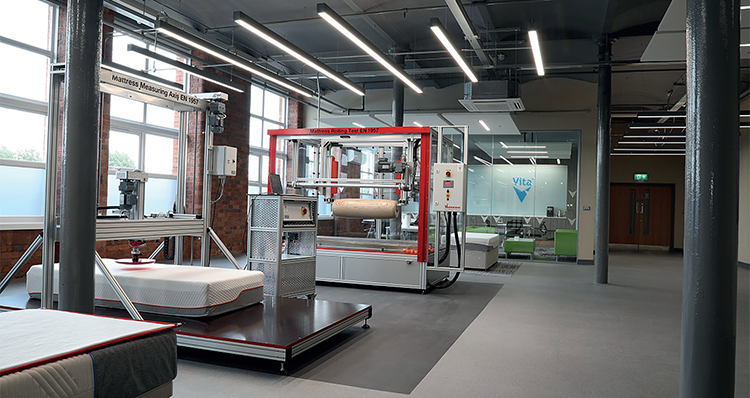
A solid alliance
Innovation often steps up a gear in times of crisis. The pandemic has certainly been no barrier to invention – with advancements being made across various sectors, most notably in diagnostics and health tech.
Despite the challenges posed by Covid-19, the nation’s collaborative spirit has thrived. In the world of science and manufacturing, projects have been progressing in the background, which could have significant implications in the future.
A perfect example of this is the partnership between The Vita Group, a leading provider of value-added and differentiated flexible polyurethane (PU) foam products and The University of Manchester’s Graphene Engineering Innovation Centre (GEIC). The two are working jointly on the development and application of enhanced foam products that exploit the remarkable properties of graphene.
Comprising a single layer of carbon atoms arranged in hexagons, graphene is 100 times stronger than steel and is the world’s thinnest material. It is extremely lightweight and a highly efficient conductor of electricity and heat.
The material was first discovered by scientists at the University of Manchester in 2004. In 2010 those same scientists were awarded the Nobel Prize for Physics, recognizing their pioneering work with graphene.
Since then, the University has launched the multimillion-pound GEIC (Graphene Engineering Innovation Centre) to provide industry-led development in graphene applications and bring real-world products to market. Based in ‘the home of graphene’, the GEIC team collaborates with industry partners to create, test and optimize new concepts for delivery to market, along with the processes required to scale up and for supply chain integration. It is here that The Vita Group comes in.
To date, little research has been carried out that combines graphene with PU foam, but it is an area with a lot of promise . As a Manchester-based business that is also the largest PU foam manufacturer in Europe, The Vita Group team reached out to the University of Manchester and the GEIC.
Mike Murray, Chief Technology Officer at The Vita Group, explains: “I had worked with the National Graphene Institute (NGI) and the GEIC before and saw how they were pushing the boundaries of research and development in terms of graphene applications. We knew that on a global basis we were only just beginning to explore how graphene can enhance polymeric materials, especially flexible PU foam. However, we  could see enormous potential to tap into here, with prospective applications across a broad spread of markets including industry, automotive, bedding & furniture, medical and construction. Fortunately, the GEIC team shared our vision and could see the benefit of two nearby organizations with overlapping expertise collaborating to accelerate innovation in this area.”
could see enormous potential to tap into here, with prospective applications across a broad spread of markets including industry, automotive, bedding & furniture, medical and construction. Fortunately, the GEIC team shared our vision and could see the benefit of two nearby organizations with overlapping expertise collaborating to accelerate innovation in this area.”
Once agreed, the joint initiative gained rapid momentum even through consecutive lockdown periods. Not only were the partners able to share a wealth of specialist knowledge and skill in their respective areas, but they were also able to benefit from shared physical resources and laboratories.
An initial seed project saw the material science being conducted partly at the GEIC’s state-of-the-art labs and The Vita Group’s Middleton Innovation Centre.
Mike says: “Our Innovation Centers – of which we have four – are designed to help us work with partners and customers to develop new, innovative and more sustainable solutions. The world-class team and testing facilities we have at our disposal at the Middleton Innovation Hub right on the University of Manchester’s doorstep lent themselves perfectly to the GEIC collaboration.”
James Baker, CEO Graphene@Manchester, added: “Building on our Bridging the Gap project, working with Greater Manchester-based SMEs, we are excited to work with companies like Vita, who have key facilities in our area. This offers further opportunities to build the local ‘ecosystem’ of businesses and drive innovation in advanced materials such as graphene to enhance products and applications.”
The early stage of the project focused on producing a good-quality PU foam that incorporated graphene – a complex, exacting process, which needed to exploit the properties of graphene without compromising the properties of the foam.
The GEIC team provided a selection of graphenes based on their experience, with The Vita Group team selecting a foam system that they believed would have the broadest application if the team could get the modification to work.
To date, the results of the collaboration have been impressive. Mike says: “The addition of graphene into the PU foam we provided produced some interesting outcomes and we saw improvements against the various properties we were targeting. Given this, we have moved onto the planning stages for the next part of our collaboration, which will be a large-scale project. Depending on the outcomes of that, we will look at developing a longer-term programme.” The benefits of forging industrial/academic alliances are clear to see in this joint endeavor. The hope now is that the project results in a ground-breaking new product that will further cement Manchester’s position as the home of graphene. It could also go some way to strengthening the UK’s world-leading reputation for material science innovation, demonstrating triumph in the face of adversity.
Mike Murray
Mike Murray is Chief Technology Officer at The Vita Group. The Vita Group
is a leading provider of value-added and differentiated flexible polyurethane (PU) foam products. Built on 70 years of heritage, Vita develops, manufactures and markets a wide range of flexible polyurethane foam, Talalay latex and flooring products to create comfort, quality and functional solutions for its customers. Vita’s three divisions – Comfort, Technical and Flooring – cater for customers across a broad set of industries, including Bed-in-the-Box mattresses and bedding, furniture, hygiene and medical, mobility, construction, and flooring.
www.thevitagroup.com